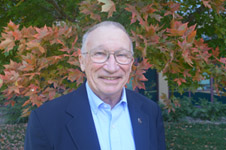Natural Resources, School of
Document Type
Article
Date of this Version
4-1995
Citation
Robert F. Diffendal, Jr. 1995. Geology of the Ogallala/High Plains Regional Aquifer System in Nebraska: Field Trip No. 6, pp. 61–75 in Geologic Field Trips in Nebraska and Adjacent Parts of Kansas and South Dakota: Parts of the 29th Annual Meetings of the North-Central and South-Central Sections, Geological Society of America. Guidebook No. 10. Lincoln: Conservation and Survey Division, Institute of Agricultural and Natural Resources, University of Nebraska–Lincoln.
Abstract
This guide is mostly figures with a reference section containing some of the pertinent literature on the Cenozoic geology we will see over the next four days. We will make all 17 stops if the weather is reasonably good and the roads are passable. On the first day, April 29, we will try to get to stops 1–5, the more distal parts of the Ogallala and younger deposits in Nebraska. On April 30, we will try to visit stops 6–9. Stops 10–15, in areas closer to the sediment sources of the Ogallala and some of the younger units, will be examined on May 1. Stops 16–17 will be made on our return trip to Lincoln.
Stop 1. Todd Valley. Our first stop will be north of North Bend, Nebraska, on the surface of the Todd Valley fill to see some of the Quaternary geomorphology of eastern Nebraska and to review some aspects of Quaternary stratigraphy in the eastern part of the state.
Stop 2. Ashfall Fossil Beds State Historical Park. This is one of the truly extraordinary mammalian vertebrate fossil localities in North America.
Stop 3. Long Pine Formation. Skinner and Hibbard (1972) described the units in this area and originally placed them in the early Pleistocene. The Keirn, Long Pine, Duffy, and Pettijohn formations have subsequently been placed in the Pliocene and are equivalent in age to the Broadwater Formation of western Nebraska.
Stop 4. Valentine Formation. This is a short stop to see some of the sands of the Valentine Formation and the Niobrara River valley.
Stop 5. Valentine and Ash Hollow formations. Skinner and Johnson (1984) subdivided these formations into a number of members, some of which can be seen exposed in road cuts and natural exposures northeast of the city of Valentine, Nebraska.
Stop 6. Snake River Falls. The geologic section exposed here was illustrated and described by Skinner and Johnson. Part of the Caprock Formation of the Ash Hollow forms the resistant ledge over which the Snake River falls.
Stop 7. Box Butte Tablelands, Niobrara Valley, and Pine Ridge. Swinehart and others (1985) have described the stratigraphy of this area in general and have placed in the Ogallala Group several units previously included by some workers in the Hemingford Group.
Stop 8. Carhenge. Considered folly by some, this piece of folk art by a local resident is intended to resemble the British stone circle, Stonehenge. Entering the North Platte Valley.
Stop 9. Duer Ranch. We will walk over parts of the area and see spectacular examples of Ogallala Group gully fills, Ash Hollow Formation sands and gravels filling channels and basal inner channels of the Broadwater Formation (=Long Pine).
Stop 10. Multiple volcanic ash deposits in the Ash Hollow Formation south of Broadwater, Nebraska. Diffendal (1984b) and Swinehart and others (1985) published maps showing the distribution of volcanic ash beds in the area.
Stop 11. Greenwood Canyon south of Bridgeport, Nebraska. A general stratigraphic section of the rocks exposed in this area was published in Stout and others (1971). Subsequently, Diffendal (1984b) studied the area and, among other things, found multiple volcanic ash beds in the Ash Hollow Formation of the Ogallala Group.
Stop 12. Early Quaternary fluvial deposits of Pumpkin Creek valley. If you look once again at figure 4, you will see that I have depicted a tributary to the North Platte River in the general position of Pumpkin Creek valley on the early Pleistocene maps, but have not shown it on the map of Pliocene drainages. This stop is at a gravel pit that yielded fossils of early Pleistocene mammals.
Stop 13. Faden and Van Pelt ranches—Ash Hollow Formation valley fills. At Faden Ranch, the basal Ash Hollow Formation fills inner channels like those of the basal Broadwater Formation on Duer Ranch. On the Van Pelt Ranch, we will look at part of one valley fill, tributary gully fills, opal beds, caliches, and other interesting features.
Stop 14. Exposures of the "typical Kimball" south of Kimball, Nebraska. This stop includes the supposed stratigraphically highest parts of the so-called Kimball Formation of the Ogallala.
Stop 15. Exposures of the "typical Sidney Gravel" near Sidney, Nebraska. We will look at compositional differences of this supposed unit, now included in an expanded Ash Hollow Formation.
Stop 16. Ash Hollow. Ash Hollow is the type area of the Ash Hollow Formation.
Stop 17. Type area of the Ogallala Group. This is the poorest type area of any we have seen. It has no exposed base and the top is erosional.



Comments
Published by the Conservation and Survey Division, Institute of Agriculture and Natural Resources, University of Nebraska–Lincoln in conjunction with the Geological Society of America regional sections meeting, April 27–28, 1995.